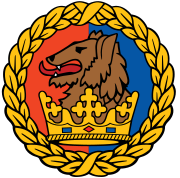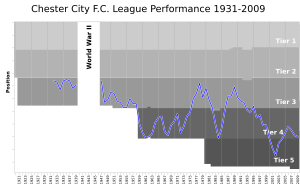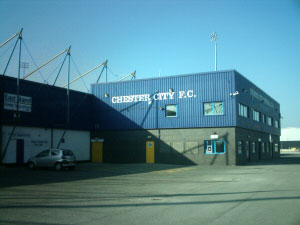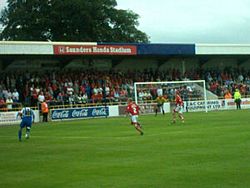Chester City F.C. facts for kids
 |
|||
| Full name | Chester City Football Club | ||
|---|---|---|---|
| Nickname(s) | The Seals The Blues |
||
| Founded | 1885 (as Chester F.C.) | ||
| Dissolved | 2010 | ||
| Ground | Deva Stadium, Chester, England | ||
| Capacity | 6,500 (5,500 seated) | ||
|
|
|||
Chester City Football Club was a football team from Chester, England. It played in different leagues from 1885 until 2010. The club played its home games at Sealand Road for a long time, from 1906 to 1991. Then, they moved to the Deva Stadium in 1992. Before that, they played two seasons at Macclesfield Town's Moss Rose stadium. Chester City also had exciting "cross-border derby" matches against the Welsh team Wrexham.
The club started in August 1885. Five years later, they joined The Combination league. They won this league in 1908–09. In 1910, they joined the Lancashire Combination and moved up from Division Two in 1910–11. They then joined the Cheshire County League in 1919. Chester City won this league three times: in 1921–22, 1925–26, and 1926–27.
Chester was voted into the Football League in 1931. They stayed in the Third Division North until 1958, when they were placed in the Fourth Division. They earned promotion in 1974–75 but were moved down again in 1982. The club changed its name from Chester to Chester City the next year. City got promoted out of the Fourth Division in 1985–86. They got back into the third tier in 1993–94, after being moved down the season before.
Chester City was moved out of the Football League in 2000. But they managed to get back in after winning the Conference title in 2003–04. In 2009, they were moved down to non-League football again. Chester City then faced serious money problems, with debts of £7 million. The tax office asked a court to close the club in January 2010. The Conference National league stopped Chester from playing because of their money issues and cancelled games. A month later, the club was removed from the league. All their results for that season were cancelled. In March 2010, Chester City was officially closed down. Supporters quickly started a new club, Chester F.C., which began in May 2010.
Contents
History of Chester City Football Club
How the Club Started and Its Early Years
Chester F.C. began in 1885. It was formed by joining two smaller clubs, Chester Rovers and Old King's Scholars F.C. At first, they played their home games at Faulkner Street.
After playing friendly games and a few cup matches, Chester joined The Combination League in 1890. In 1898, the club moved to The Old Showground. But they had to leave a year later because houses were built there. This meant the club stopped playing for a short time. In 1901, they moved to Whipcord Lane. Again, they didn't stay long, moving out in 1906. Their new stadium on Sealand Road, simply called The Stadium, became their first long-term home. Here, they won their first league title, the Combination League, in 1909. In 1910, Chester joined the Lancashire Combination League. They stayed there until after World War I. Then, they helped start the Cheshire County League. Charlie Hewitt became manager in 1930. In 1931, he led Chester City to join the Football League.
From the 1930s to the 1970s
In the 1930s, Chester always finished in the top ten of Division Three North. During this time, Chester had their biggest win in the FA Cup, beating Fulham 5–0 in 1933. In 1936, they had their biggest league win, beating York City 12–0.
Chester also won the Welsh Cup for the second time. They beat their rivals Wrexham at Sealand Road in May 1933. They also won the Football League Division Three North Cup two times in a row. Sadly, the team was split up when World War II started. Even though they finished third in 1946–47 and won another Welsh Cup, hard times followed. They didn't finish in the top half of the league until 1958. That's when the lower divisions were combined, and Chester was placed in Division Four. They had to wait another six years to finish above the middle of the league table.
Chester's luck started to change when South African Peter Hauser became manager in 1963. He helped Chester aim for promotion from Division Four. In 1964–65, all five of their forwards scored 20 goals each. This was a special achievement. Chester scored 119 goals in Football League games that season, but they still missed out on promotion.
Except for missing promotion by just one point in 1970–71, the next few years were quiet. Chester started the 1974–75 season as the only Football League team that had never been promoted. They finally broke this streak by finishing fourth in Division Four. They just beat Lincoln City to promotion by a tiny difference in goal average. Ken Roberts was the first Chester manager to win promotion in the Football League.
That season, Chester also reached the Football League Cup semi-finals. After beating Walsall, Blackpool, and Preston North End, Chester played against the Football League champions Leeds United. Two goals from John James and one from Trevor Storton gave Chester a 3–0 win. This is seen as one of the biggest upsets in the cup's history. In the next round, a goal from James helped them beat Newcastle United in a home replay. This set up a semi-final game against Aston Villa. Brian Little's late goal in the second game at Villa Park sealed a 5–4 win for Villa, who went on to win the cup.
Chester started to settle in the Third Division. They had good runs in the FA Cup, reaching the fifth round in 1976–77 and 1979–80. This was under manager Alan Oakes, who used to play for Manchester City. In 1978, they achieved their best position since the lower divisions were changed in the late 1950s, finishing fifth. They missed promotion by only two points. Chester was also one of only two teams to win the short-lived Debenhams Cup. This was a competition for the two teams from outside the top two divisions who went farthest in the FA Cup. They beat Port Vale 4–3 overall in 1977 to win their first English national trophy. Chester also continued to surprise bigger teams. They knocked First Division team Coventry City out of the League Cup in 1978–79. A year later, they beat Second Division leaders Newcastle United in the FA Cup. One of the goal scorers was a young player from their own team, Ian Rush. He later moved to Liverpool for £300,000 and became one of the most famous Welsh strikers ever.
Chester City's Later Years
After Ian Rush left, Chester didn't score as many goals. By 1982, they were back in the lowest division. Two years later, they finished last in the entire Football League. But they were allowed to stay in the league. By this time, the club was known as Chester City, a name they added in 1983. A future star who played for Chester during this time was Lee Dixon. He later won many big awards with Arsenal and played 22 times for England.
Thanks to new players like Milton Graham, John Kelly, and Stuart Rimmer, and smart management by Harry McNally, Chester returned to the Third Division in 1986. Three years later, they almost made it to the play-offs. McNally did amazing things with a small budget. But more tough times were ahead. In 1990, Chester had to leave their Sealand Road home. They temporarily shared Macclesfield's Moss Rose ground. Even with very small crowds, Chester managed to avoid being moved down from Division Three in both 1990–91 and 1991–92. They returned to Chester in 1992, to the new Deva Stadium. This was in the renamed Division Two after the Football League changed its structure. The first official match at the Deva Stadium was on August 25, 1992, against Stockport County. The visitors won 2–1. The next Saturday, Chester City won their first League game at their new home, beating Burnley 3–0. The Deva Stadium is interesting because it's right on the border between England and Wales. The football pitch is in Wales, but the entrance and some club offices are in England.
Chester was moved down in their first season back in Chester. But they quickly won promotion back as Division Three runners-up. The manager Graham Barrow unexpectedly left, and several key players also departed in 1994. This left Chester with a very small team, and they were easily moved down to Division Three again in 1995. They stayed there for five years. In 1997, they lost a play-off semi-final to Swansea City.
Money Problems and the End of the Club
Under owner Mark Guterman, Chester faced financial difficulties in October 1998. The club managed to stay in Third Division under Kevin Ratcliffe in 1998–99. The American Terry Smith bought the club in July 1999. Ratcliffe left the next month, and Smith became manager. He only saw four league wins in four months. Ian Atkins was brought in as manager, but Chester lost their place in the Football League on May 6, 2000. This happened after losing to Peterborough United, due to a small difference in goals scored.
In their first season in the Football Conference, Chester finished 8th. But the season was overshadowed by ongoing problems behind the scenes. By the summer of 2001, Chester was in serious danger of closing down. The owner's friend Gordon Hill was made manager, which fans didn't like at all. A new chairman, Stephen Vaughan, arrived in September 2001. He appointed Mark Wright as manager, and Chester avoided being moved down in 2002. A year later, they reached the Conference play-offs. But they missed out on promotion after losing a penalty shoot-out to Doncaster Rovers.
Starting the 2003–04 season, Chester was expected to win the Football Conference. They only lost four games that season. They won the title and promotion back to the Football League with a 1–0 win over Scarborough in their second-to-last match. This was the club's first national league title.
The day before the 2004–05 season began, Mark Wright resigned. Ray Mathias took over temporarily. By the end of August, Chester was at the bottom of the League. The new manager, Ian Rush, helped the club avoid being moved down. But other managers criticized him for using "long ball" tactics. Rush resigned in April 2005 after the chairman Stephen Vaughan fired his assistant manager without Rush knowing.
In April 2005, Keith Curle took over. A series of bad results saw Chester drop from fourth place to last in Football League Two. Mark Wright surprisingly returned to the club. A run of five wins in a row late in the season meant they would stay in the Football League for another year. The 2006–07 season was special because the club was put back into the FA Cup. This happened after Bury, who had beaten Chester, were removed for playing a player who wasn't allowed to play. Wright was fired in April 2007 and replaced by Bobby Williamson. Williamson was fired in March 2008 after Chester had won only one of their last fourteen games. Club coach Simon Davies took over. They avoided being moved down in the second-to-last game of the season with a 0–0 draw against Stockport County. They finished 22nd, their lowest position since returning to the Football League in 2004–05.
A bad start to 2008–09 led to Davies being fired in November 2008. The club was out of all cup competitions and struggling in the league. Mark Wright returned for his third time as manager. Chester continued to struggle, and a 2–1 home loss to Darlington on the last day of the season meant Chester was moved down to non-league football after five years in The Football League. Two weeks after the final match, the club faced financial difficulties.
The next month, people the club owed money to voted to accept a plan by Stephen Vaughan's family to save the club. This happened before the Football Conference board's meeting, where the club was accepted into the Conference National but with a 10-point penalty. Mick Wadsworth became the new manager.
In the summer of 2009, Chester City was put under the control of experts to try and sort out its money problems. It had debts of £7 million. This led to a 10-point penalty. This penalty later increased to 25 points. A possible buyer appeared, but the deal didn't happen. A new buyer was found on May 26, 2009, which was a company set up by former chairman Stephen Vaughan and his family. The Football Association held back the club's membership transfer. On the day before the new season, they stopped Chester City FC from playing their first game. This happened less than 24 hours after the Football Conference said Chester could play in the fifth tier of English football. The club had to cut back on its youth training program. Fans waited at the Deva Stadium for a meeting to find out about the club's future.
Chester City FC released a statement on August 10, 2009. It described meetings about the club's membership transfer. They confirmed that another home match had been cancelled. The statement ended by saying they were very frustrated with the whole process. The FA finally allowed the membership transfer on August 13, 2009.
On the field, Mick Wadsworth was fired after a bad start to the season. He even said the club's atmosphere was worse than Gretna F.C.'s, which he had managed when it was closing down. Jim Harvey replaced Wadsworth and quickly improved the team's performance. This gave fans a small hope that the club might survive. However, fewer people came to games, and money problems continued. Players were gradually let go to save money. Harvey was also fired in January 2010 by Morrell Maison, the club's new football director, who then became manager. He oversaw what was probably the club's lowest point when only 518 people came to see the team lose 1–0 to a lower-league team. By this time, Chester was far behind at the bottom of the table, and results didn't get better. The club's last match was a 2–1 home loss against Ebbsfleet United.
On February 9, 2010, Chester City failed to play a game against Forest Green Rovers. Reports said players refused to get on the team bus because they hadn't been paid. Three days later, the Football Conference stopped Chester from playing for seven days. This was to give them time to sort out their money and respond to breaking five league rules. At a meeting on February 18, it was suggested that Chester be removed from the league because the board wasn't sure the club could play its games. The final decision was up to the other clubs.
At this point, Chester was at the very bottom of the Conference National. The club was removed from the league after a vote on February 26. All their results for the season were cancelled. On March 9, the club tried to join the Welsh Premier League. But the club was officially closed down by the court the next day. The club's supporters' group, City Fans United (CFU), announced they wanted to start a new club in the lower English football leagues.
Fewer people coming to games didn't help the club in its final years. The average number of fans was almost 3,000 in the 2005–06 season. But in the season they were moved down three years later, it fell below 2,000. In the club's last season, fewer than 1,300 people came to games on average. The lowest number of fans was only 425 on January 19 (the lowest league attendance in the club's history). The attendance at the club's final home game on February 6 was 460.
On March 25, 2010, it was announced that CFU's new club would be called Chester F.C.. It would play at the old club's Deva Stadium. The new club started playing in July 2010. It was placed in Northern Premier League Division One North, three levels below where Chester City had been. The new Chester F.C. earned three promotions in a row, reaching the Conference Premier in 2013.
Club Colours and Badges
|
|
| Chester's original home colours |
Chester's first colours were red and white. They used these colours until the club temporarily stopped playing in 1899. The colours changed to green and white in 1901 when the club moved to Whipcord Lane. They used different combinations until World War I. These included green shirts with white shorts, green and white stripes, and green and white halves. In 1919, the colours changed again to dark green shirts, which earned Chester the nickname the Ivies. In 1920, the colours changed again to black and white, giving Chester the nickname Magpies. Black and white remained the colours until 1930, when they changed to blue and white stripes. For the next thirty years, the colours stayed the same, except for the 1952–53 season, when Chester wore white shirts and black shorts.
The colours changed again in the 1959–60 season to green shirts and socks with gold trim, and white shorts. In 1962, Chester went back to blue and white stripes, but with thinner blue stripes and blue shorts instead of black ones. The 1968–69 season saw Chester change to an all-sky blue kit, which they used for four years. In the 1972–73 season, the club again went back to blue and white stripes. In 1974, the "seals" badge appeared on the kit for the first time. A shirt sponsor first appeared on Chester's kit in the 1982–83 season. The blue and white colours and the seals badge disappeared in the 1983–84 season. The renamed Chester City F.C. changed to blue shirts and white shorts. The shirt became mostly blue in the 1988–89 season, which was the last season at Sealand Road. The first season at the Deva Stadium saw the colours change to a blue shirt with white speckles. The colours returned to blue and white stripes the next season. From 1995, the club wore blue and white stripes of different thicknesses and shades.
In the 1958–59 season, the city's coat of arms was added to the shirt. In the early to mid-1960s, the supporters' association badge was used. From 1974–75 to 1982–83, the club used the "seals" badge. This design was chosen from a competition held by a local newspaper. The club's final badge was a version of the City of Chester crest.
Who Managed the Team?
Here is a list of the managers who led Chester City Football Club:
|
|
Rival Teams
Chester City had a long-standing rivalry with Wrexham. These clubs were only 12 miles apart, but they were separated by the border between England and Wales. Wrexham won more of these "cross-border derby" matches in the English Football League, with 30 victories compared to Chester's 26. Between 1986 and 2005, the teams were in the same division for only one season. But they were then opponents in Football League Two for three seasons from 2005–06 to 2007–08. In 2009–10, the teams played again in the Conference National after Chester also left the Football League. Their last game was a 0–0 draw before Chester City closed down.
Tranmere Rovers and Crewe Alexandra were also traditional rivals. However, Chester hadn't played either of them in a league game since the early 1990s. More recently, a rivalry grew between Chester and Shrewsbury Town. This was after some controversial games. In November 2006, a big fight broke out between players from both teams at the end of Chester's 2–1 loss.
A short rivalry also started with Stockport County after an incident involving a Chester player. Macclesfield Town were also county rivals with Chester.
Player Achievements
Most Games Played in the Football League
Most Goals Scored in the Football League
Other Player Records
- Most league goals in one season: 36 by Dick Yates (1946–47)
- Highest amount paid for a player: £150,000 for Kevin Ellison (2007)
- Highest amount received for selling a player: £300,000 for Ian Rush (1980)
- Most games played in a row in the league: 133 by John Danby (2006–2009)
- Oldest player in a league game: Stan Pearson, 40 years and 101 days old (April 1959)
- Youngest player in a league game: Aidan Newhouse, 15 years and 350 days old (May 1988)
- Player with most international games: 35 by Angus Eve for Trinidad & Tobago; (for UK nations) 13 by Billy Lewis for Wales
Trophies and Awards
Domestic Trophies
- Football League Division 3 North
-
- Second Place (1): 1935–36
- Football League Division 3 (now League 2)
-
- Second Place (1): 1993–94
- Football League Division 4 (now League 2)
-
- Second Place (1): 1985–86
- Football Conference
-
- Winners (1): 2003–04
- Cheshire County League
-
- Winners (3): 1921–22, 1925–26, 1926–27
- Second Place (1): 1930–31
- The Combination
-
- Winners (1): 1908–09
- Second Place (5): 1903–04, 1904–05, 1905–06, 1906–07, 1907–08
- Welsh Cup
-
- Winners (3): 1908, 1933, 1947
- Second Place (10): 1909, 1910, 1935, 1936, 1953, 1954, 1955, 1958, 1966, 1970
- Lancashire Senior Cup
-
- Winners (1): 1957
- Debenhams Cup
-
- Winners (1): 1977
- Division 3N Cup
-
- Winners (2): 1936, 1937
- Second Place (1): 1946
- Bob Lord Trophy
-
- Winners (1): 2001
- Conference Championship Shield
-
- Second Place (1): 2001–02
Players Who Played for Their Country
| Years | Nationality | Name | Apps | Goals |
|---|---|---|---|---|
| 1887–1892 | Sam Jones (Wales international) |
— | — | |
| 1888–1891 | Robert Lee Roberts (Wales international) |
— | — | |
| 1889–1891 1895–1896 |
Ben Lewis (Wales international) |
— | — | |
| 1892–1898 | Billy Lewis (Wales international) |
— | — | |
| 1907–1914 | Billy Matthews (Wales international) |
— | — | |
| 1938–1955 | Tommy Astbury (Wales international) |
303 | 38 | |
| 1948–1951 1956–1961 |
Billy Foulkes (Wales international) |
118 | 14 | |
| 1957–1959 | Stan Pearson (England international) |
57 | 16 | |
| 1961–1964 | Peter Fitzgerald (Republic of Ireland international) |
80 | 12 | |
| 1978–1980 | Ian Rush (Wales International) |
34 | 18 | |
| 1983–1986 | Andy Holden (footballer) (Wales International) |
100 | 16 | |
| 1984–1985 | Lee Dixon (England international) |
57 | 1 | |
| 1986–1996 | Billy Stewart (England semi-pro international) |
317 | 0 | |
| 1991–1993 | Arthur Albiston (Scotland international) |
68 | 10 | |
| 1993–1998 | Iain Jenkins (Northern Ireland international) |
195 | 1 | |
| 1995–1996 | Cyrille Regis (England international) |
29 | 7 | |
| 1999–2000 | Angus Eve (Trinidad and Tobago international) |
14 | 0 | |
| 2006 | Derek Asamoah (Ghana international) |
17 | 8 | |
| 2006 | Stephane Gillet (Luxembourg international) |
8 | 0 | |
| 2006–2007 | Roberto Martínez (Belgium national coach) |
31 | 3 |
See also
 In Spanish: Chester City Football Club para niños
In Spanish: Chester City Football Club para niños





